Total Weight:
73.9 lbs (33.52 kg)
Battery Weight:
7.1 lbs (3.22 kg)
Motor Weight:
9.47 lbs (4.29 kg)
Frame Material:
6061 Aluminum Alloy, Hydroformed
Frame Sizes:
17.75 in (45.08 cm)Geometry Measurements:
17.75" Seat Tube, 22.5" Reach, 26.75" Stand Over Height, 31.5" Minimum Saddle Height, 37.5" Maximum Saddle Height, 27.5" Width, 77" Length, 47" Wheelbase
Frame Types:
High-Step
Frame Colors:
Matt Graphite Grey with Black and Gloss Metallic Red Accents
Frame Fork Details:
RST Guide 26 Coil Suspension, 80mm Travel, Lockout, Preload Adjust, 32mm Stanchions, 135mm Hub Spacing, 9mm Axle with Quick Release Skewer
Frame Rear Details:
175mm Hub Spacing, 12mm Threaded Slotted Axle, 18mm Nuts
Attachment Points:
Fender Bosses, Rear Rack Bosses, Bottle Cage Bosses
Gearing Details:
8
Speed 1x8 Shimano Altus Derailleur, Shimano HG MEGARANGE CS-HG41-8ao 11-34 Tooth Nickel Plated CassetteShifter Details:
Shimano Rapidfire Triggers on Right (One-Way High Lever, Three-Shift Low Lever)
Cranks:
Prowheel Zephyr Forged Aluminum Alloy, 170mm Length, 104 BCD 38 Tooth Narrow Wide Steel Chainring with Aluminum Alloy Guard
Pedals:
Wellgo K79 Aluminum Alloy Platform, Large, Fixed Pins
Headset:
Neco Threadless, Internal Cups, Cartridge Bearing, Straight 1-1/8" (44mm Outer Diameter)
Stem:
Promax Adjustable Angle (+40 and -40 Degrees), 110mm Length, 31.8mm Clamp Diameter, One 20mm Tapered Spacer, One 5mm Spacers, One 15mm Tapered Spacer
Handlebar:
Promax, Aluminum Alloy, Low-Rise, 690mm Length, Black
Brake Details:
Tektro Aries Mechanical Disc with 180mm Rotors, Four-Finger Levers with Rubberized Edge, Integrated Bell, Motor Inhibitors
Grips:
Velo, Flat Rubber, Locking, Black
Saddle:
Selle Royal Viento, Sport, Black
Seat Post:
Promax, Aluminum Alloy, Single-Bolt Clamp
Seat Post Length:
350 mm
Seat Post Diameter:
30.4 mm
Rims:
Aluminum Alloy, Double Wall, Punched Out, 95mm Width, 36 Hole, Black
Spokes:
Stainless Steel, 13 Gauge Front, 12 Gauge Rear, Adjustable Brass Nipples, Black
Tire Brand:
Kenda Juggernaut, 26" x 4.5" (116-559)
Wheel Sizes:
26 in (66.04cm)Tire Details:
5 to 30 PSI, 0.4 to 2.1 BAR, 60 TPI Casing
Tube Details:
Schrader Valve
Accessories:
Custom iGO Rear Rack with Standard Gauge Pannier Hangers and Triple Bungee Strap (25kg 55lb Max Weight), Aluminum Alloy Fenders (110mm Width), Oversteer Bumpers on Downtube, Clear Sticker Slap Guard, Rear-Mount Adjustable Kickstand (40mm Bolt Spacing), Buchel Shiny 50 Integrated Front Light (50 Lumen, Side Windows), Buchel Edge Integrated Rear Light (2 LED)
Other:
Locking Removable Integrated Downtube Battery Pack, MDA 1.6lb 54.6 Volt 2 Amp Charger, Ergofit System Allows the Seat to Reach Lower Positions and the Stem and Handlebars to Adjust, Internal Cable Routing, 48 Volt 22 Amp 9 Mosfet Controller (Proprietary Programming), 136kg (300lbs) Max Load, Rust Resistant KMC Z8
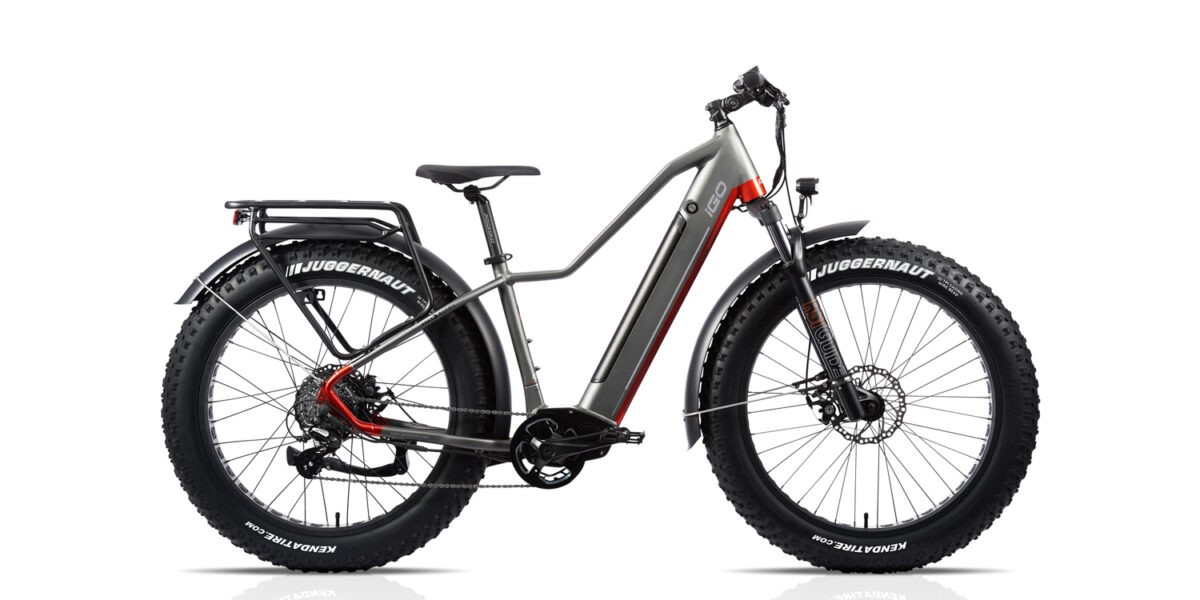
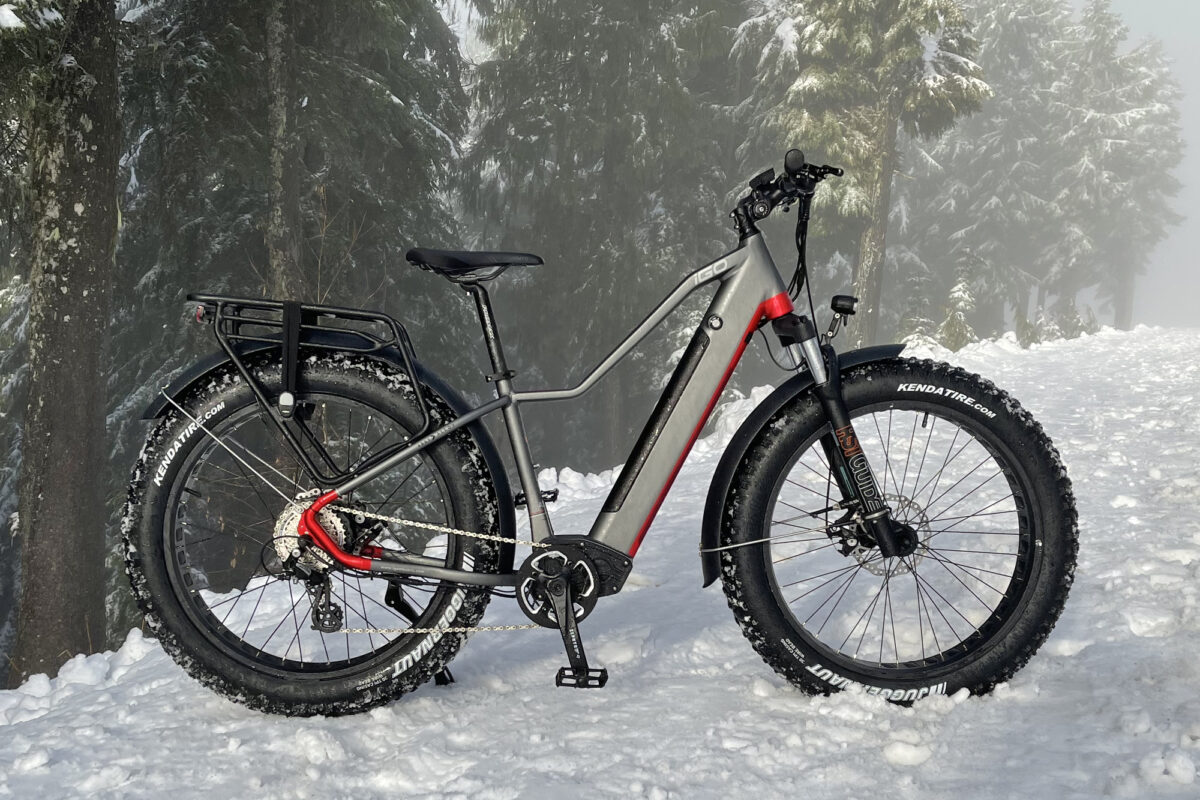

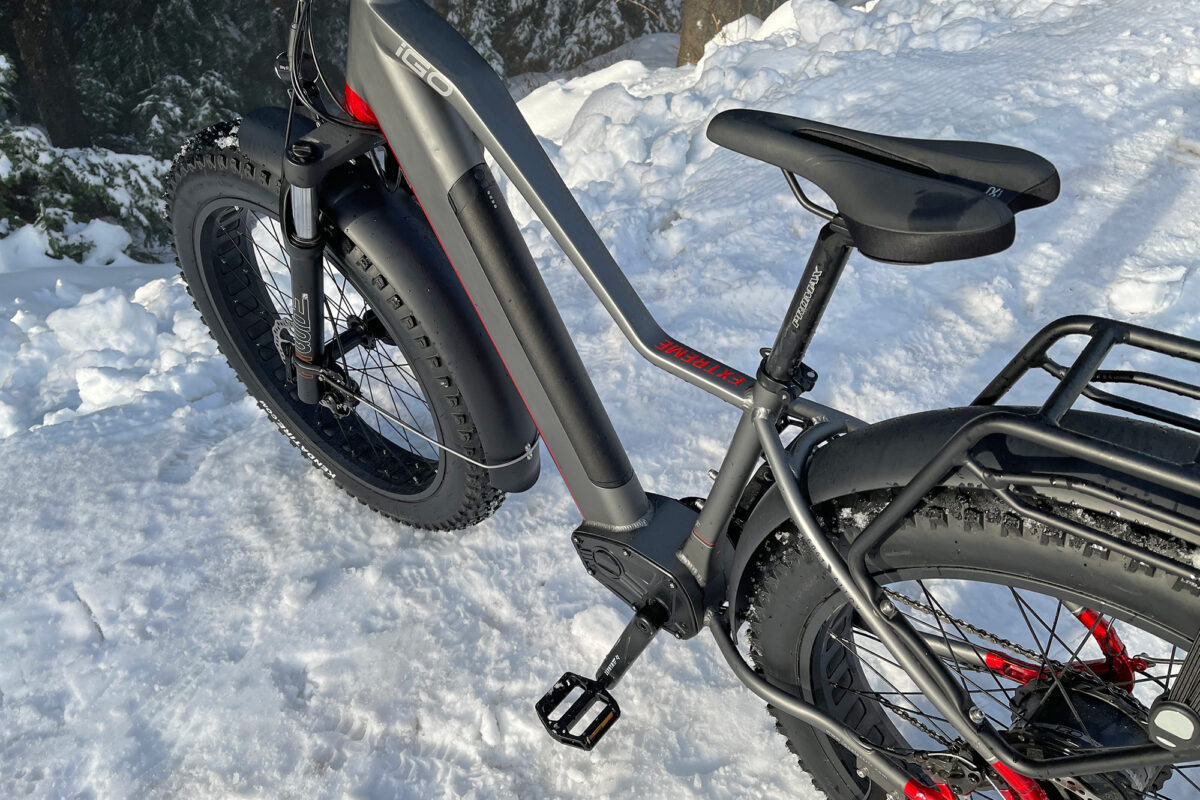

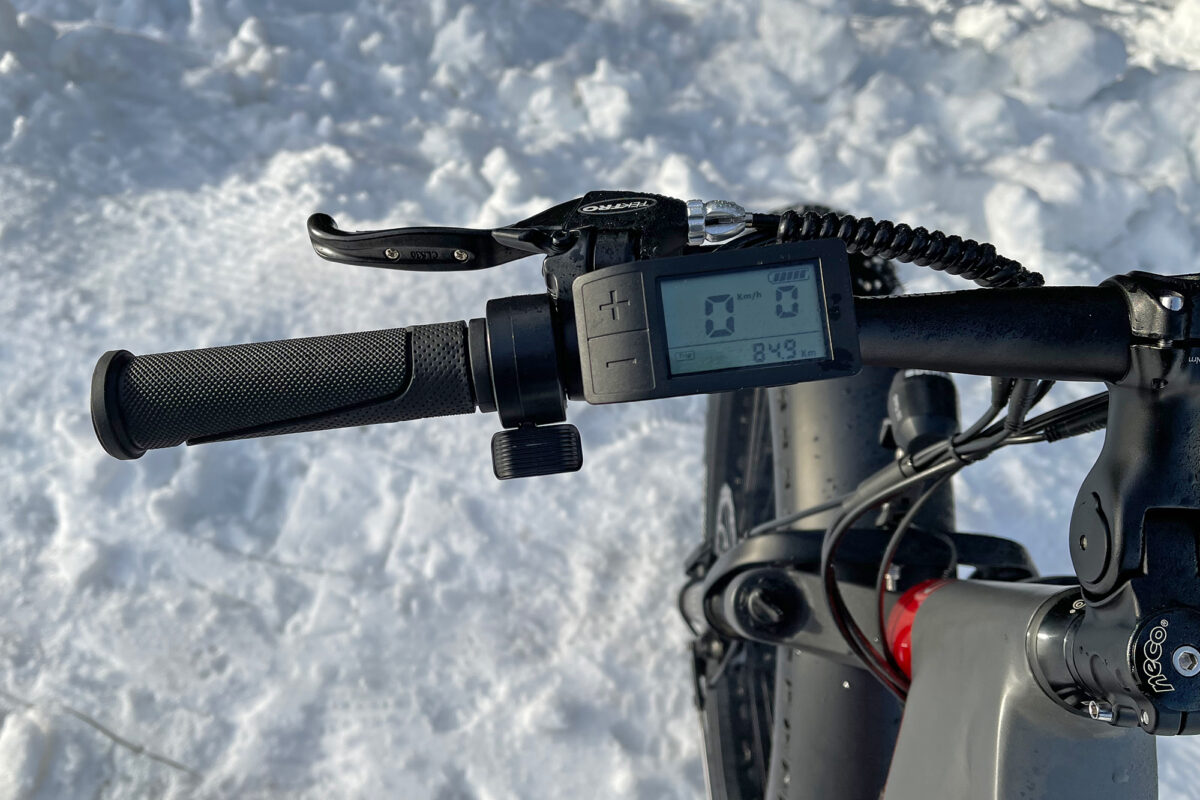

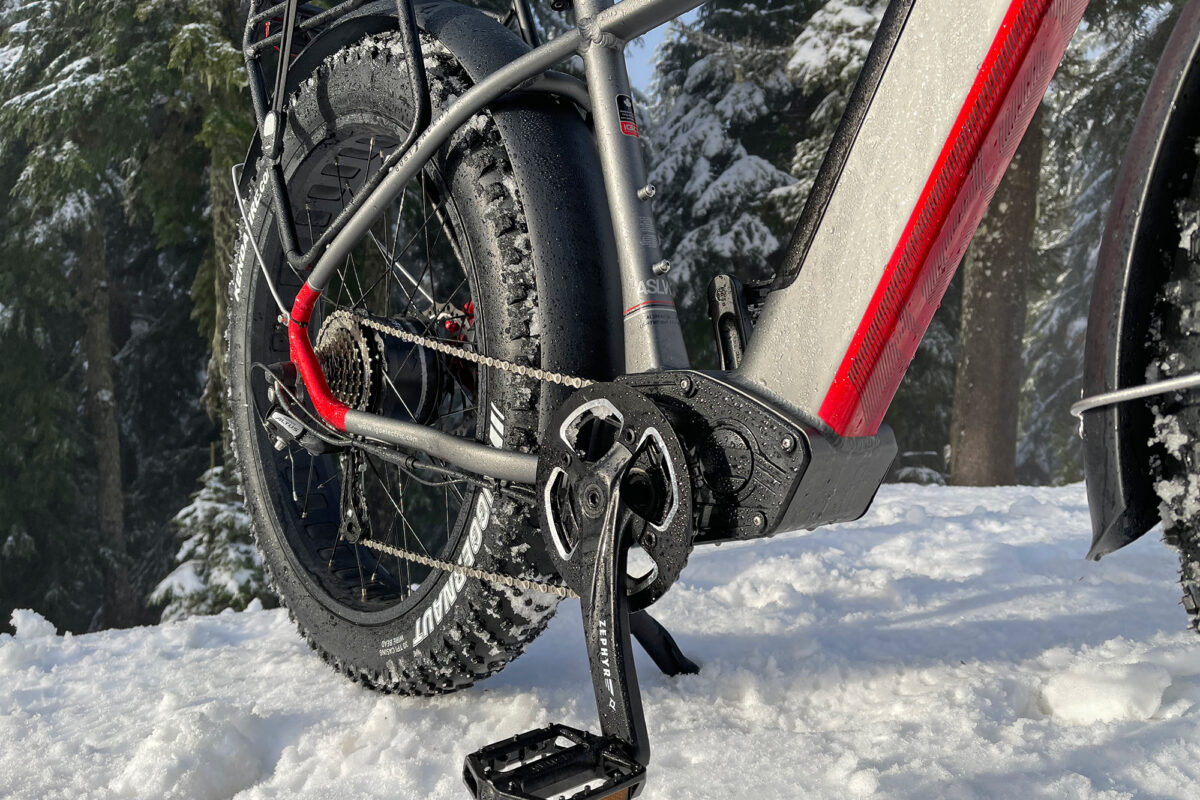

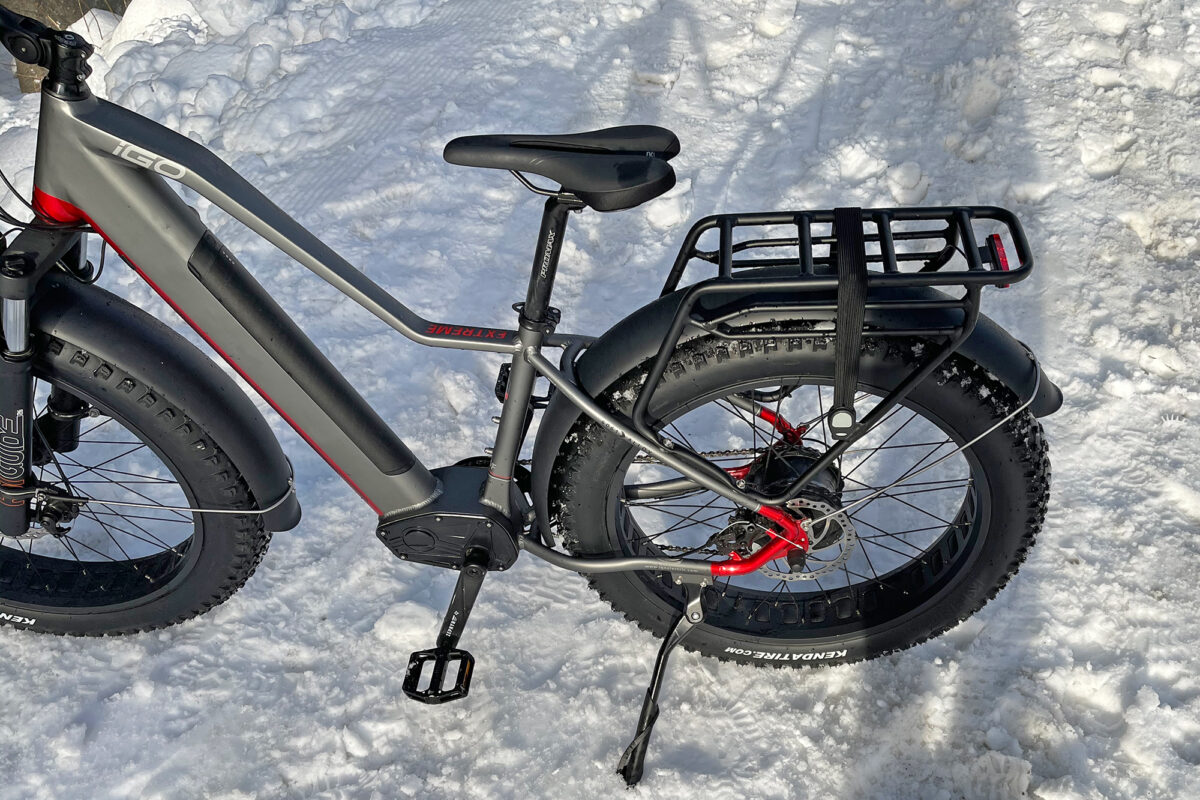
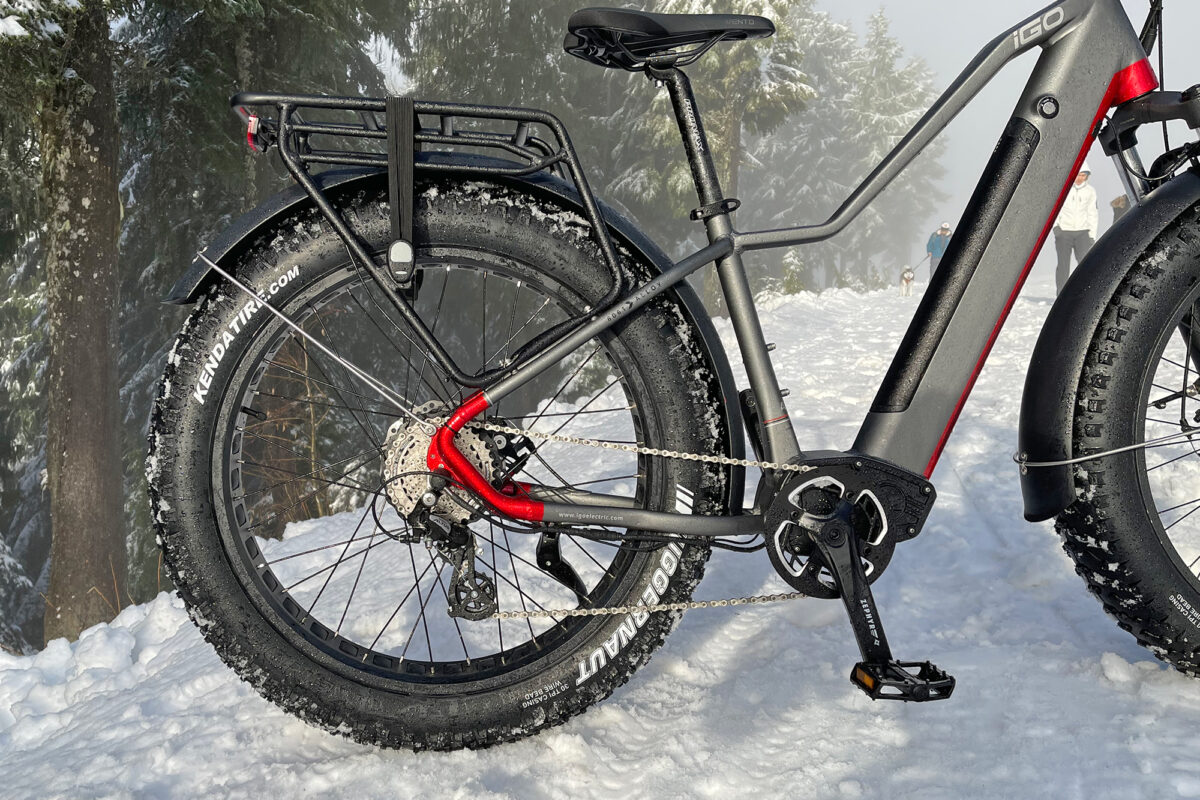



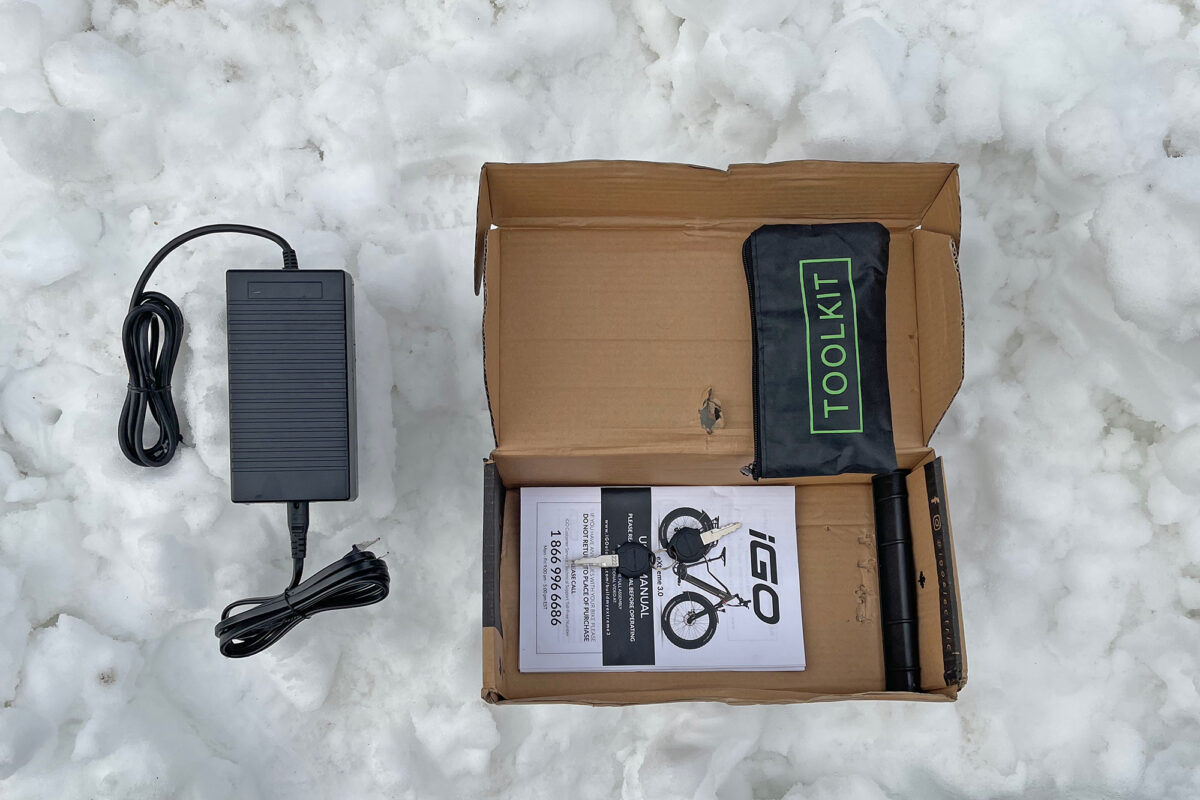
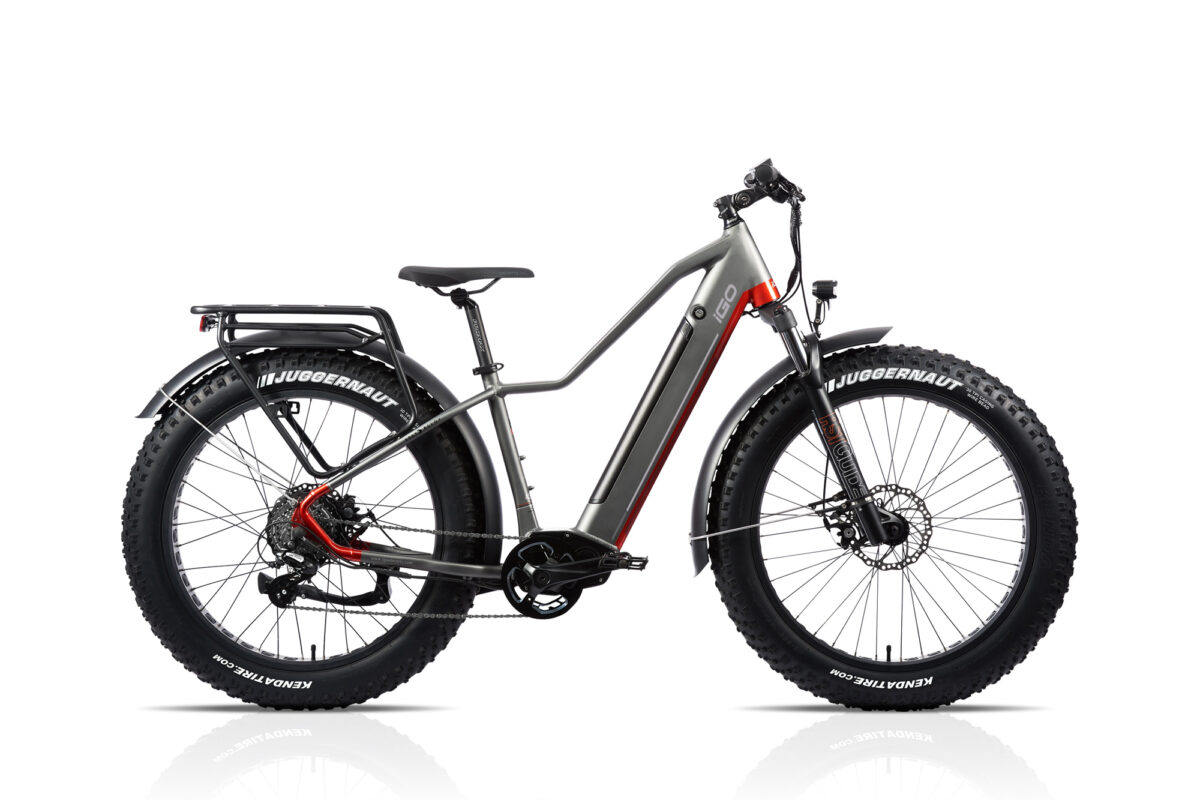
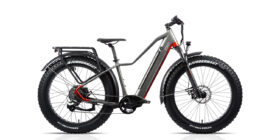
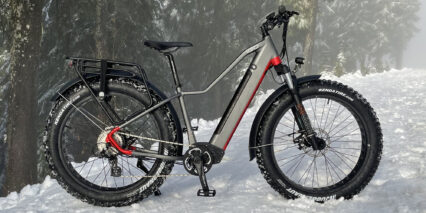
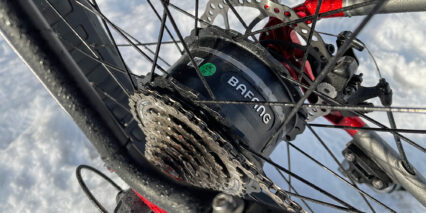
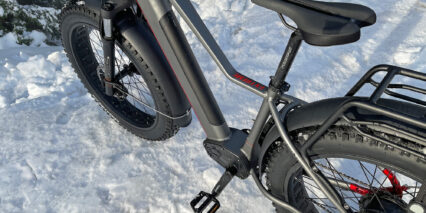

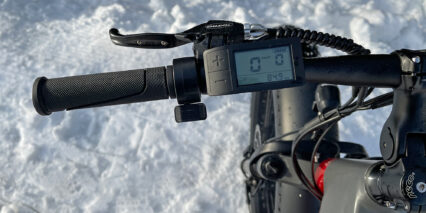
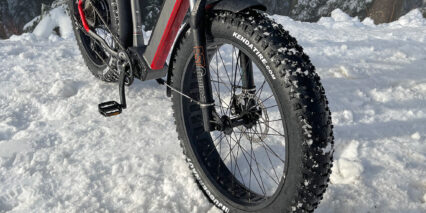


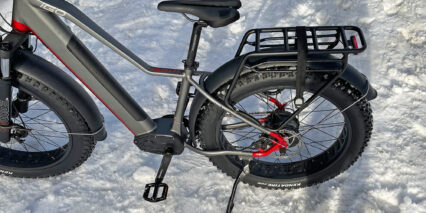
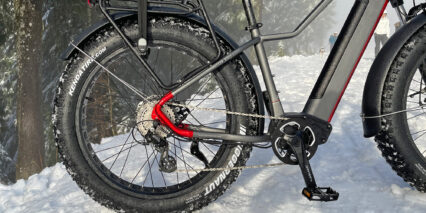
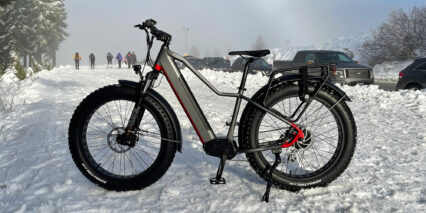
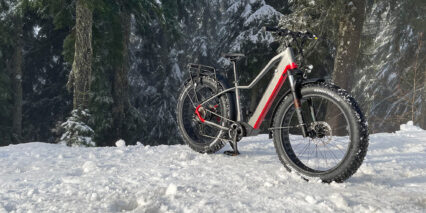
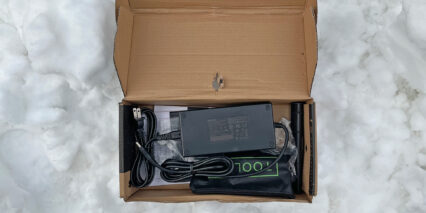
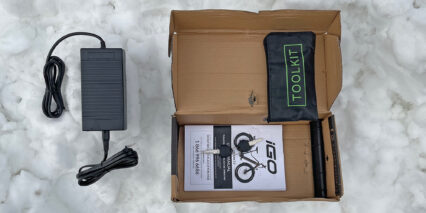
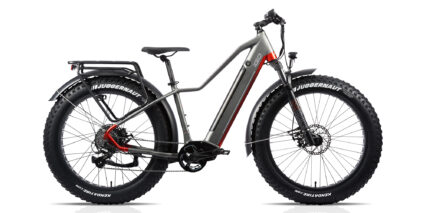

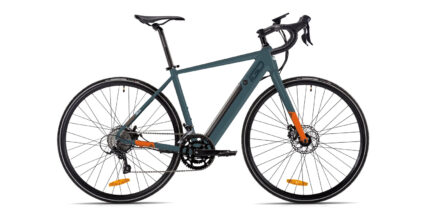
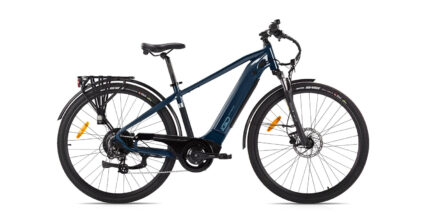
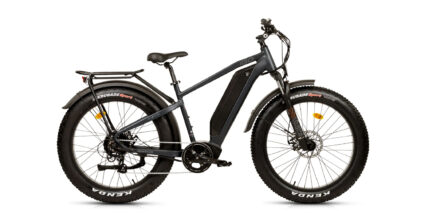
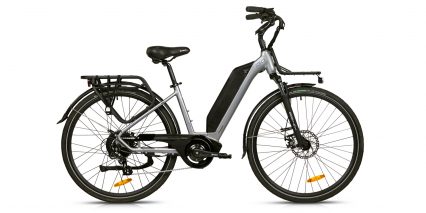
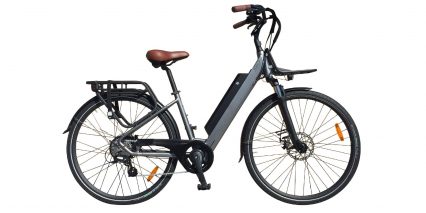

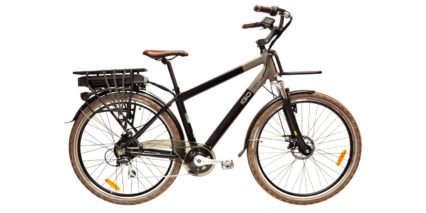
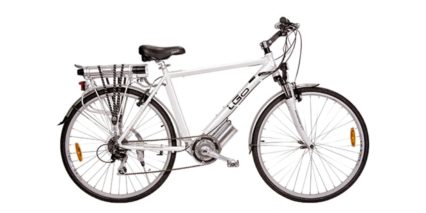
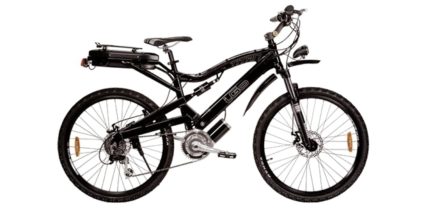

Douglas
4 years agoThose winter-y pics are great!
ReplyCourt
4 years agoThanks Douglas! It was a special day for sure, I thought they looked amazing too… the bike is just glistening with the fresh clean snow and spray from riding around all morning :D
ReplyBart
4 years agoHow do you feel about this bike in comparison to Voltbike Yukon 750? I ordered Voltbike because of the 17.5ah vs 13ah battery as well as hydraulic brakes on Yukon. The rest feels very similar in specs. I had a chance of test-driving Yukon, and at the time Yukon was $200 cheaper than iGo (sold in Costco). It was a tough decision to make and I’m still waiting for my Voltbike to arrive. I’m not sure if I made the right choice though. Any suggestions?
ReplyCourt
4 years agoHi Bart! I feel that VoltBike has been doing a wonderful job in recent years. I haven’t covered their latest models, but they look great. It’s a company that has earned my trust, who I see working hard to provide good customer service. I think that you made a great decision. This iGO is a fairly new model that probably wasn’t available in the final form (or maybe it was at Costco?) I think both of these Canadian companies are doing good, and I hope you enjoy your bike. Feel free to share about it here or in the VoltBike forums as you receive and ride it :)
ReplyAlan
4 years agoHow does the iGO Core Extreme 3.0 compare to NCM Moscow which is $1,700 Canadian during Christmas season now?
ReplyCourt
4 years agoHi Alan! I prefer iGO, even though it’s slightly more expensive. This is because I have seen a strong push for customer service and noticed that their frames, batteries, and displays are customized… but not in ways that are frivolous or introduce complexity. I feel that iGO is doing an excellent job in ways that I care about and I just haven’t seen as much engagement from NCM. I feel like they are aiming for lower prices, and I know that the founder is very smart and has some great international connections. That said, if you buy from Amazon or direct from them, I feel like there could be more issues (this is based on comments in the NCM reviews I’ve done and in the NCM ebike forums). Don’t just take my word for it though, I feel like I’m a bit out of touch with that brand and never had the same level of connection that was built with iGO over nearly eight years now.
ReplyRich
4 years agoHi Court, it’s listed as $2499 CAD on the iGO website.
ReplyCourt
4 years agoHmm, thanks Rich! Maybe they raised the Canadian price based on demand or limited inventory? I record what I see or am told at the time of review… but this is a very fresh review so maybe I’ll update it ;)
ReplyKen
4 years agoI am looking for an e-bike, mainly for commuting, and my work is 5 miles away. I am trying to determine if the RadRover 5 or IGO Extreme 3.0 is better. I read the reviews and compared them, and can’t decide. Since I am commuting on roads, I would weigh easy and reliable more important than rugged. Any thoughts on which would be better would be greatly appreciated. Thank you for the reviews, they are extremely helpful!
ReplyCourt
4 years agoHi Ken! Glad the reviews are helping you out! Great question here… I’d go for the RadRover 5 if my rides were mostly in town. I like their rack accessories… but would skip them to save money and weight if I wasn’t actually using them. The plastic fenders are nice and the wheels in general are not as wide, so parking at bike racks will be easier, same with going through doors. Both have nice lights, the bell, and great customer support. I like the upright handlebar on the RadRover more than the adjustable stem, and I like how universal their battery packs are. You also get excellent resale value with Rad. It’s a close call in many ways, and I love the way the iGO Core Extreme 3.0 looks :)
ReplyKen
4 years agoThanks Court! That is very helpful and made my decision.
Marie-Diane
4 years agoHi Court. We love to watch your reviews! Always very thorough and fun to watch. My boyfriend and I are hesitating between the new IGO Extreme 3.0 and the Teo Velo S500 2021. Tks!
ReplyCourt
4 years agoHey Marie, thanks! Glad the site is helping you. I haven’t covered a Teo model for a couple of years, I’m not even in touch with them lately? My experience with the S Limited model was pretty good, but they were just starting out. IGO is a much larger company with a long history in the ebike space. Their frames and controllers are very custom, but well done. All things equal, I’d probably go with iGO… but I don’t mean to speak negatively of Teo because I’m sure they would love you as a customer and the S500 looks pretty sweet!
ReplyMarie-Diane
4 years agoThanks Court! Purchase made!
Marie-Diane
3 years agoHello Court! Our bikes should be shipped from BC on February 12th. We can’t wait to try them out! We’ll be sure to post our comments. Our biggest concern now is finding a bike rack. The only one that seems to fit the weight of these bikes is from Hollywood Racks (HR1500), but it is sold out at the moment. Any suggestions? Thanks again!
ReplyCourt
3 years agoHi Marie-Diane! I hear you, lots of ebike stuff has been selling out recently. My friend found this company “Buzz Rack” a while back and he purchased the E-Scorpion 2 for his electric bikes. He said it worked well, and I think he bought it off of e-Bay but this is their official site with all of the models ;) I hope it helps you.
ReplyMarie-Diane
3 years agoHi Court! We finally received our new bikes! We are so excited. First time with an electric bike. Lots of power on this one! We’re very happy with our purchase. Unfortunately, all the electric bike racks are sold out at this point. We may opt for a trailer which would allow us to carry our 2 bikes and our 16.5 foot kayak. Thanks again!
Greg Ferrao
3 years agoHi Court, excellent review (as always)! I would like to try something totally different so I’m interested in fat-tire eBikes. I’m trying to decide between the Voltbike Yukon (20″) or this iGO Extreme 3.0.
Two quick questions…
Any advice you could offer between the two bikes would be greatly appreciated. Thanks again for all your hard work.
ReplyGREG
Court
3 years agoHi Greg! Great questions, and kudos for trying something a bit different… or at least considering it ;)
Fat tires can add weight, drag, and change steering a bit (less quick to turn, but won’t get hung up in deep cracks like train tracks). I also noticed that sometimes as the bike turns, you actually have to steer against the tire wanting to turn further in. This might be called oversteer in the motorcycle world. I like their stability, comfort, and go-anywhere capabilities!
The iGO did feel “approachable” to me, and I know that they worked hard to make a design that was strong but also had that sloped top tube and easier stand-over. This is important for mounting and for dismounting in uneven terrain. You could go all the way to step-thru with something like the RadRover Step-Thru, but the frame won’t be quite as stiff, and you’ll have a hub motor vs. more powerful and more efficient mid-drive with iGO Core Extreme 3.0 :)
ReplyPeter
3 years agoHi Court, I enjoyed your video review on the iGO Extreme 3.0, well done and very thorough. You mentioned the bike was a medium/large. I am wondering (because it only comes in one size), if it would be suitable for me at 6’0″ and perhaps my son could also use it? He is 6’4″. What are your thoughts? Thanks, Peter.
ReplyCourt
3 years agoHi Peter! Yeah, I think it would be workable for you two… and you could always swap the seat post, stem, and handlebar to extend reach and height. I’ve noticed that most frame size differences are just an inch or two in terms of reach or height, so you can get a similar change of geometry with these accessories, even just sliding the saddle back a bit. I hope this helps, it would be nice if they had multiple sizes, but this is one way that many companies keep their prices low.
ReplyGreg Ferrao
3 years agoHi Court, thanks for the fun review. It really helped me make a final decision. The bike has been out of stock for a while so I contacted iGo directly and found out they were getting a shipment this week. I was refreshing the Extreme 3.0 webpage more then I would like to admit. Yesterday morning it was still listed as out of stock but at 11 am (ET) the magic ‘add to cart’ button appeared so I was able to purchase one! Very excited. By the evening they were out of stock again. They must get a very limit number of units.
So for anyone looking to buy one I found it very helpful to contact the sales department to get an idea of when they would be in stock again. Really looking forward to getting/riding my new bike!
Thanks again.
ReplyCourt
3 years agoGreat suggestion, Greg! It’s nice to be able to reach a sales department that is helpful and has some good info to share. I’m sure you’ll enjoy the bike, but if you have anything to share once you’ve spent some time in the saddle, do chime in here again!
ReplyGreg Ferrao
3 years agoFYI… I happened to get a iGo customer service reply from an older inquiry. They are expecting the next shipment of Extreme 3.0 bikes in the fall of 2021.
Mike Eckhardt
3 years agoHey Court, another amazing review. I’ve always been on and off the fence about purchasing an e-bike so have been for close to 1.5yr watching your videos and even if I wasn’t planning on purchasing an e-bike I enjoy your videos. Informative and generally fun to watch.
I have decided on the iGo Core Extreme 3 for purchase but was curious about the weight capacity the bike can handle. Amy advice on that, did I miss it in your video maybe? I am a heavier rider and carry gear when riding so was wondering how it could handle maybe 250-275lbs total. I usually have about 50lbs of gear since this will be used during my camping trips for remote locations.
Thanks again for your time and wicked reviews. Cheers mate
ReplyCourt
3 years agoHey! Thanks for the positive support Mike. Yeah, this is a good one… Sorry it took me some time to respond to your comment here. I was reading the details and see that this ebike is rated to handle 300lbs max load (that’s what I was told). The rear rack is rated to 55lbs, so you’re looking at about 250 rider + 250 on the rack if I understand correctly. That’s pretty standard for bigger bikes like this, most regular bikes and ebikes seem to be rated at 250lbs. The first failure point seems to be spokes, that get loose and then the wheel goes out of true. Keep an eye on the wheels and make fixes/adjustments quickly. You could also use Loctite blue to secure the nipples if you notice them loosening over time. I haven’t tried this, but have read it online several times ;) good luck!!
ReplyMike
3 years agoHey, thanks for the response my man. Appreciate the feedback. At 200lbs this will be more than enough for me. Thanks again for the feedback and reviews. Keep the reviews coming.
ian
3 years agoI purchased the IGO Extreme 3 from Costco in Feb/21. It was missing the battery. I contacted both IGO and Costco to resolve the issue. IGO was unsympathetic and refused to assist me. They wanted to charge $699 retail plus $120 for a battery. Over $800 for a battery, which, btw is only 624Wh! I suggest people stay away from IGO for their poor customer support, and well as their expensive and weak batteries. I also suggest that potential IGO customers research the exorbitant cost of battery replacement on all of their models before purchase. Costco allowed me to return the bike btw. No more IGO for me.
ReplyCourt
3 years agoHi Ian! Wow, I’m glad that you got a refund. It sounds like you had to jump through some hoops, sorry to hear that the the bike didn’t come with a battery, that’s so odd. My experience reviewing ebikes here can be extra smooth sometimes, because the companies facilitate everything to make it easy. I haven’t ever bought an ebike from a big box store… and while I’d appreciate the convenience, I can see how support might be non-existent for repairs and service ongoing. Sorry to hear that iGo didn’t step up for you more :/
ReplyMartin
3 years agoPretty in depth review… one thing not covered that is most important to me is the range of the battery. If pedaling with assist, how far can a single charge take you? I’m looking at a 45km ride to work, and wondering if it could make it that distance. The site says 55km range…but from what I’ve seen, not a single electric bike on the market has ever reached the advertised range. And with this one there must be a difference between letting the bike do all the work vs you pedaling for part of the trip. I don’t want to work that hard on way to work and arrive all sweaty and gross, and would rather have a nice leisurely ride. Going home would be different, but again, I’m not pedaling a full 45km home after a long day, I’d rather the bike did the work! But will this one make the journey on one charge if I charge during the day?
ReplyCourt
3 years agoHi Martin! That’s a great question, and I’ll do my best to answer based on my own cycling experiences and feedback from shops. Range will depend on battery charge level, age and condition of the battery, outside temperature (freezing cold can reduce range 50% temporarily), tire pressure (low tire significantly cuts range), tire contact patch drag (big heavy tires with deep tread like this one are less efficient), weight of the bike itself the rider and gear, hills, how soft the terrain is, and wind. Pedaling helps, not using the throttle so much also helps, riding with lower levels of assist can help, the type of assist makes a difference (cadence sensors are less efficient than multi-sensors), hub motors are less efficient in general than mid-drives. There are lots of factors, but I do think that you could make it to and from work with this ebike by using the lower levels of assist, pedaling along, and keeping your tire pressure at the higher levels if you’re someone who weighs less than or about 170lbs (that’s the weight that many companies use when testing) and if the conditions are good. My own estimates for range on this ebike are something like 48km to 80km if using pedal assist, but I could be way off :)
ReplyMartin
3 years agoHey Court! Thanks for the fast reply… ok, more detail. I’m 5’8″ and only 155lbs, so not much weight for the bike to pull! ha ha I’d be riding mostly during spring, summer and fall and during nice days, I wouldn’t be riding in rain, snow etc. So using pedal assist for most of the 45km journey, as I said, I don’t want to arrive at work sweaty, so counting on the bike to do most of the work while I leisurely pedal. So if keeping it at a low setting, and pedaling the whole way, and keeping tires full, it should make that distance easily? Charge during the day and make it back home hopefully… getting there is mostly downhill grades while coming home would be uphill grades. The black version of the bike is at Costco here in Alberta right now for $1,899 CAD, so that’s why I’m interested. Also, how is the seat for long rides? I sat on it, and it’s not the best seat for comfort I have to say!
Paolo Bigit
2 years agoI bought mine from Costco BC on Jan 2nd. As of today I’ve done almost 800KM of commuting back forth, and I’m an avid biker and commuter. The weight was the hardest part to get used to… I’ll say roughly after the 20th ride I started to feel the difference and rides got easier and I was able to use less of the pedal-assist.
Freezing temperatures made my battery last for a max of 30KM with pedal assist 2-3. (temps between -10 to -29) As soon as temperatures started to rise, the battery range started to increase. Now, with average 5-10 degrees I’m able to do between 45KM to 60KM using pedal assist 1-4. We had a week with +10 temperatures and I managed to pull a nice 108KM on my battery.
My city has lots of incline areas. From 2.3% inclines all the way to 18% inclines. My best suggestion is that you also ride the bike whenever you are free with little to no pedal assist for weight training. I do this at least twice a week and so far, I’m able to pull more and more KM with the lower pedal assist levels.
Lately I’ve been using the rear rack for my video equipment and also have some extra pockets for my meals and clothes (just overall 25-30 extra pounds) and I’m still able to pull a great 50-67KM range per battery charge. So it depends on your strength, trails/roads you are riding, and how much you use the battery for.
ReplyCourt
2 years agoHi Paolo, this is excellent data. Thanks for recording and sharing the range you’ve been able to achieve along with the ambient temperature outside. It sounds like you are really enjoying the bike! I spend a lot of time in British Columbia and know how hilly it can be. I like how you’re seeing that riding is building your strength, and even riding without assist at times for strength training. Great job!
Martin
2 years agoWow that’s great info from real world experience Paolo! Thanks for that… Unfortunately the bikes were a one time sale at the Costco here in Airdrie Alberta, and I haven’t seen them come back since! I’m now looking into doing an electric upgrade to my Specialized Rockhopper mountain bike using a kit. I’ve seen some decent motors for $500.
Paul Gareau
1 year agoI purchased the IGO Extreme. 3.1EZ. It is essentially an updated step-thru model of the 3.0. I appreciate the step-thru on any bike, but especially on a heavier fat e-bike. Setup was easy – there is a video on the IGO website, and really not all that much assembly required. I had a problem with the display, which IGO immediately took care of – IGO customer support is excellent!
Pros
– The bike is very sturdy and well made.
– Given the large 26 x 4.5 inch tires, and the suspension front fork, the ride is very comfortable
– The motor is very strong and smooth and the hydraulic disc brakes work flawlessly.
– I love having the throttle option….great for starting from a stop or for quick acceleration out of trouble. I also like the thumb throttle over a grip throttle – but perhaps this is just a personal preference.
– Nice choice of gearing that has a choice of lows to easily get you up any hill, and a good high top gear that affords a fast cruising speed.
– I also really like a cadence sensor, although I know this puts me outside most e-bike purists thinking. (Sometimes I like to go fast without peddling too hard. I can appreciate the more natural feel of a torque sensor, but I prefer the strong immediate motor engagement of a cadence sensor).
– The stand does not interfere with the pedal.
– The charging port is super convenient, high on the right side.
– Sturdy metal fenders – no rattles,
– The rear rack is firmly attached with four bolts to the frame (no flimsy bolt attachment to the rear fender)
– Bike design allows for easy access to all cables should servicing be required.
– Looks great – battery integrated into the frame, cables nicely grouped, excellent fit and finish.
– The bike comes fully equipped with fenders, stand, bell, rear rack, water bottle bosses, tool kit and front and rear lights.
– You can go absolutely anywhere on this bike – snow, gravel, sand or regular pavement – it is a beast.
Cons
– It is a fat e-bike, and like most fat e-bikes it is heavy, not very agile, and has a more limited range than regular e-bikes.
– The bike did not come with an adjustable handlebar stem.
– The is no puncture protection on the tires.
– No suspension seat post (I added a Suntour NCX suspension seat post and a more cushy seat for a super comfortable ride)
– I appreciate the included front and rear lights which run off the battery, but I wish that manufacturers would add a flashing option on the rear light which would be great for daytime rides.
I am very impressed with the bike. With its strong motor, sturdy build, big tires and powerful brakes, it can take you through the most challenging conditions or terrain. It could also be a comfortable (if heavy) daily driver. Given the solid build, the quality components and the full array of included accessories, this bike is a very solid ride and a great value.
ReplyCourt
1 year agoGreat review, Paul! Thanks for sharing your insights and opinions about the iGO Electric Core Extreme 3.0. The company has been easy for me to work with, and they produce unique thoughtful electric bikes. Nice to have a company like this in the space, especially from Canada :)
Reply